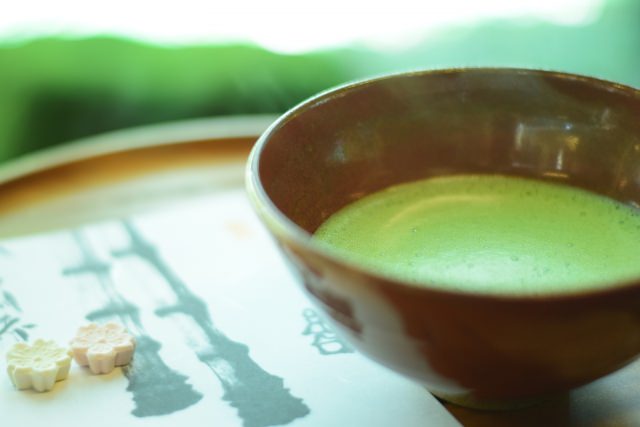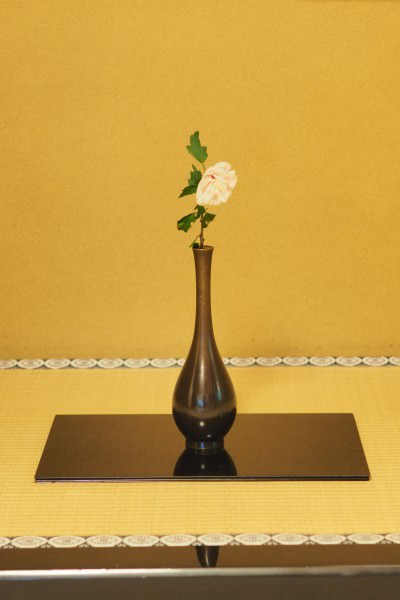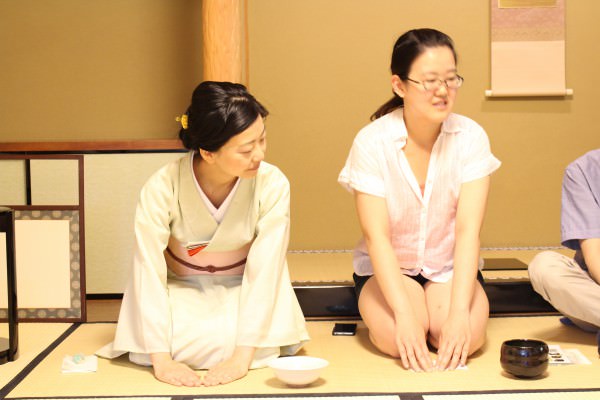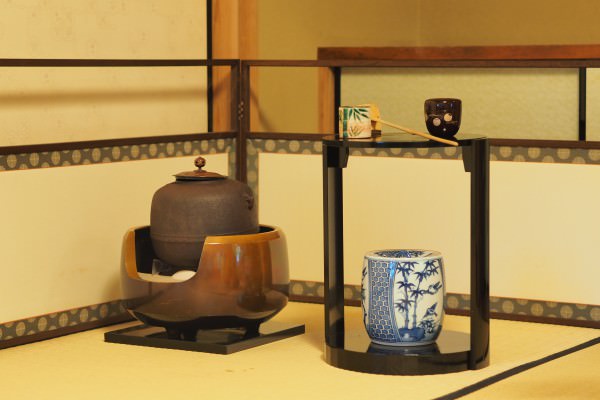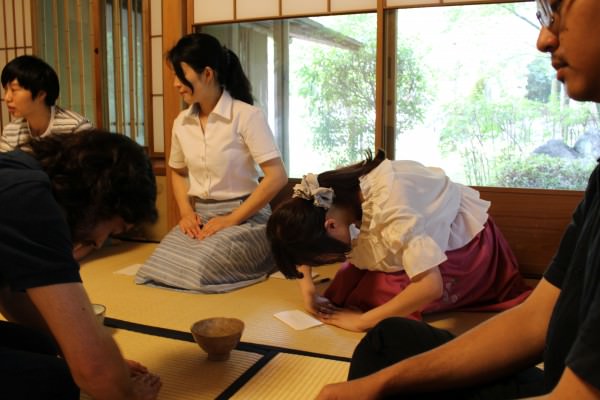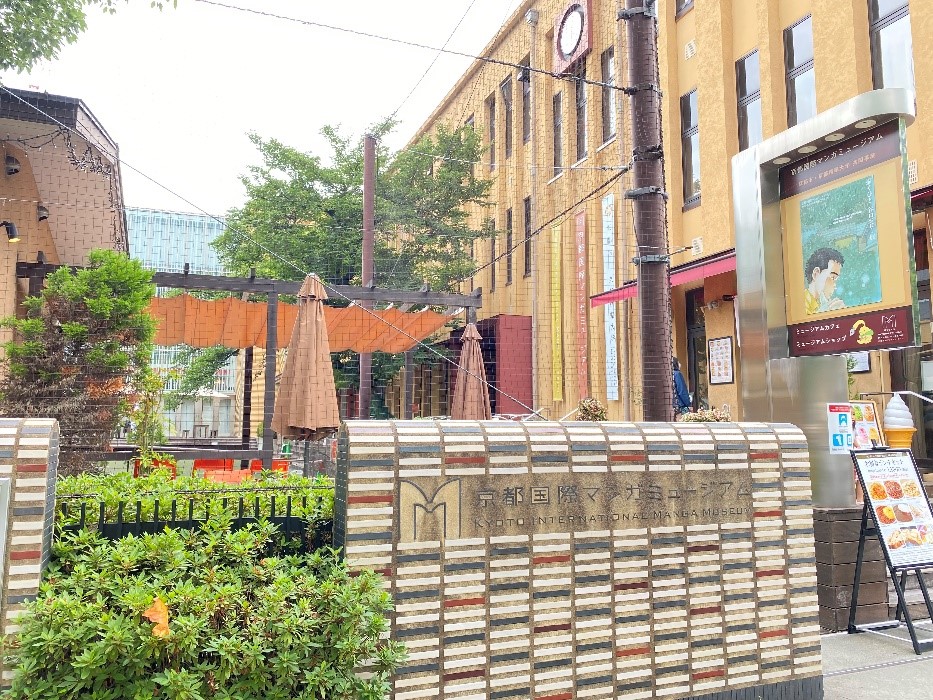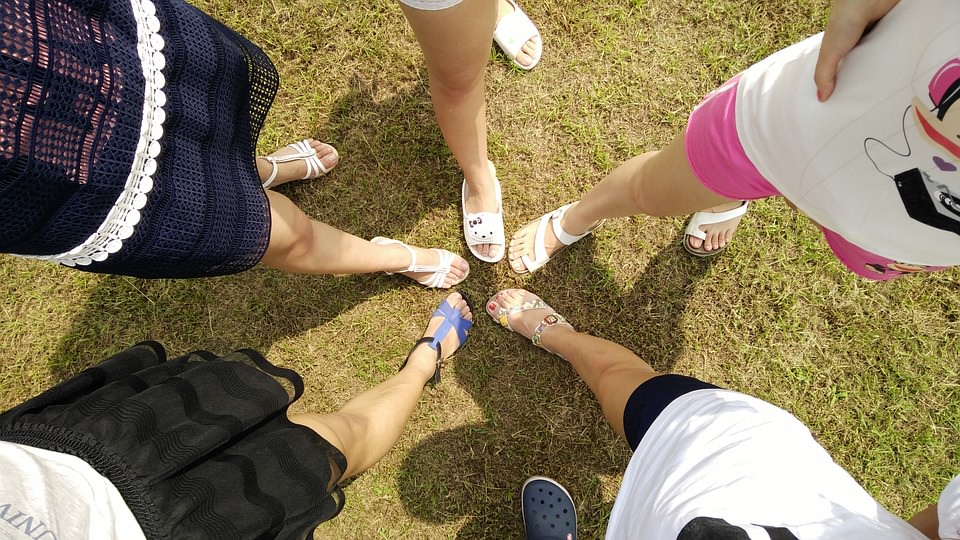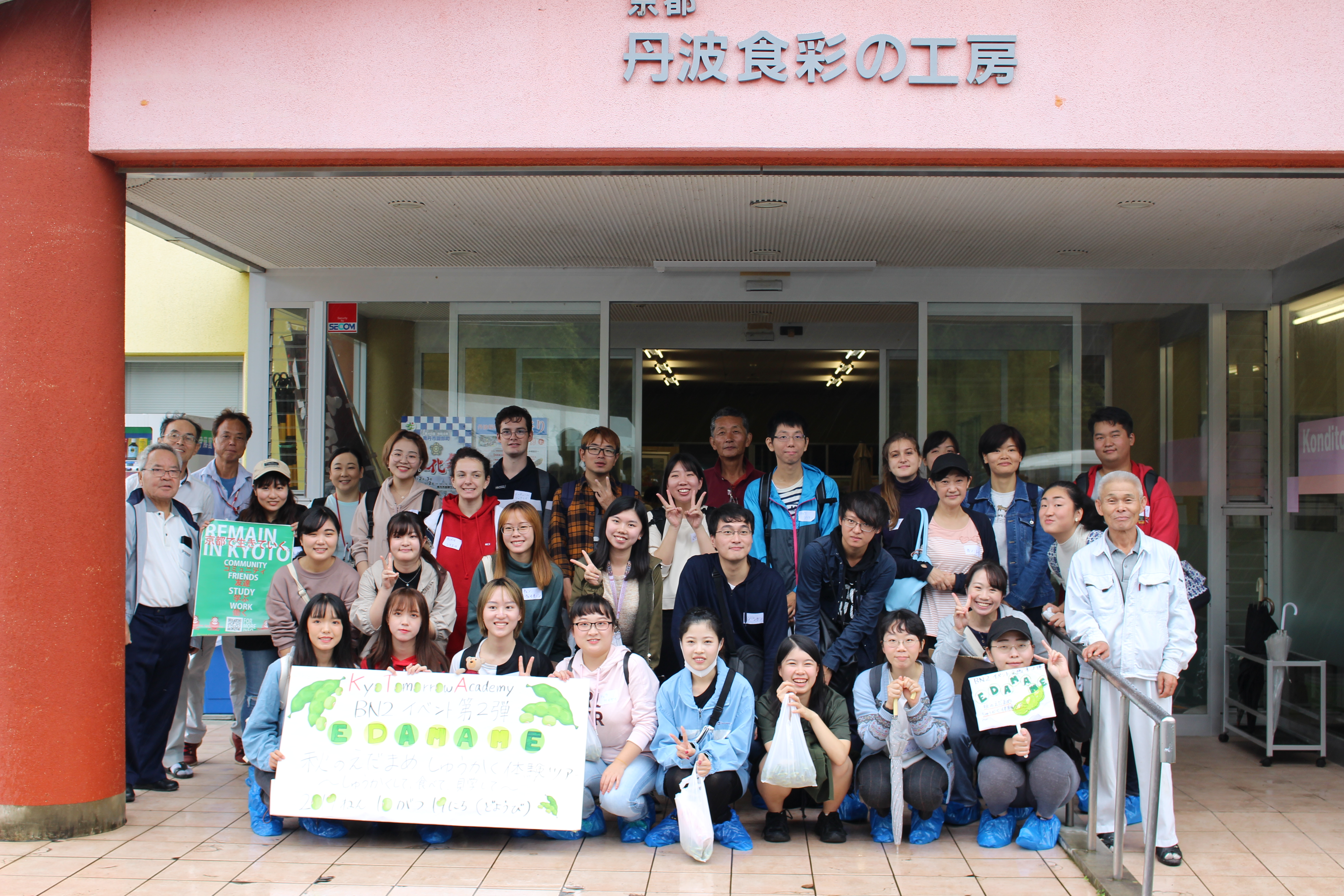การสัมผัสวัฒนธรรมญี่ปุ่นสำหรับนักเรียนต่างชาติในเกียวโต
2017.06.27
Tea Ceremony
Tea, and the practice of whipping ground tea powder into a frothy drink, were both brought to Japan by Buddhist monks returning from visits to China. Until around the 16th century, tea and tea-drinking were considered symbols of high status, and did not begin to develop the practices and philosophy of the tea ceremony we know today until around the Muromachi Period (1336-1573).
Tea ceremony is also responsible for the creation of the concept of “ichi-go ichi-e” (literally, “one time, one meeting”), coined, it is said, by Sen no Rikyu, one of the most well-known figures in tea ceremony. According to this idea, each meeting should be treasured, as it is a once-in-a-lifetime event, a moment that can never be reproduced. Once could say the same for study abroad: it’s a unique experience in which you’re gathered together with a group of unique individuals from around the world.
This year, an “Introduction to the Way of Tea” 3 month course will be offered at Kyoto’s International Hall (国際会館), offering an in-depth introduction to Japanese tea ceremony. The course is designed for non-Japanese students, and will meet for a total of 12 times. Those who wish to continue their studies after completion of the course can continue on to receive certification. The course fees are student-friendly, but hurry: applications are first come, first served!
Kyoto International Student PR Team
Ye Leying, first year Masters student from China, currently studying at the Kyoto College of Graduate Studies for Infomatics (Applied Information Technology Research Course).
“This past Tuesday, a few of us international students visited the Kyoto International Community House (Kokoka) with Study Kyoto, and tried Japanese tea ceremony.
I’m from Fujian, China, the birthplace of tea; my father loves tea, and whenever we have guests, we always serve them tea gathered around the dining table.
Japanese and Chinese tea ceremonies are completely different, so this was a good opportunity for me to get to know the world of tea ceremony here on a deeper level. Aside from the teacher, the other participants in the tea room were all non-Japanese, so the teacher gently and carefully explained each of the tea ceremony customs and the reasons behind them in English.
For example, after you’ve eaten the sweet served with your tea, you fold away the paper it was served on into your kimono and leave nothing behind.
Before drinking your tea, you need to rotate the tea bowl you’ve been served. The person who made the tea offers the tea bowl to the guest with the patterned side facing outwards. The guest is then expected to turn the bowl, etiquette that is expected because it is considered rude to touch your lips to the side of the tea bowl with a pattern. From these etiquette rules, I came to understand that the most important thing in tea ceremony is the exchange between host and guest that begins with the host’s modest approach to the guest.
The interior of the tea room was decorated with seasonally-appropriate ikebana arrangements, and the beauty of a folding screen depicting the Gion Festival’s Folding Screen Festival (Byobu Matsuri) in particular caught my eye.
Personally, I felt Japanese tea ceremony to be a mix of everyday actions, artistic aesthetics, and manners. This experience was a short one, but in the tea room I was able to forget about my usual busyness, and just enjoy the mysterious air of the room, and the slowness of time.”
Chonlada Charoenviriyakul is a second year PhD student from Thailand. She currently studies at Kyoto University’s Graduate School of Pharmaceutical Sciences.
“I too recently went along to participate in a tea ceremony lesson, just one of Japan’s traditional cultural arts. The four most important elements of tea ceremony—harmony, respect, purity, and tranquility—all express very Japanese qualities. Firstly, the ceremony takes place in a tea room laid with tatami mats. There are a number of manners that participants are required to follow when they join. For example, you’re required to be wearing socks when you enter the tea room. When you’re given tea or sweets, you need to bow the person next to you and say, “Pardon me for eating first” (Osaki ni). Again, before you drink your tea, you need to bow and say, “I humbly accept this tea” (Otemae choudai itashimasu).
The tea served in tea ceremony is matcha, but there are two varieties: usu-cha, or weaker tea, and koi-cha, stronger tea. During our lesson, we had usu-cha. Though usu-cha is supposed to be the weaker variety, to my non-Japanese taste buds, it seemed like just the right strength of flavor. If we’d been served koi-cha instead, I’m not sure I would have been able to drink it.
During our lesson, we were served tea by non-Japanese people studying tea ceremony. Everyone seemed a bit nervous, but I wanted to cheer them on. Aside from the tea itself, we were also served sweets. The kind we were served are called seiryu, or “clear stream,” a kind of summer sweet made to give a sense of coolness. They were delicious!
Through tea ceremony, I felt I was able to come touch upon a kind of Japanese-ness, or Japanese sensibility. I was also able to taste some delicious tea and sweets! Today was a very good day.”
พิธีชงชาเป็นหนึ่งในวัฒนธรรมประเพณีดั้งเดิมของญี่ปุ่น พิธีชงชานี้แสดงความเป็นญี่ปุ่น ความเคารพต่ออีกฝ่าย ความบริสุทธิ์ และความสงบ พิธีชงชานี้จัดขึ้นในห้องแบบญี่ปุ่นที่ปูเสื่อทาทามิ ในการเข้าร่วมพิธีชงชานั้นมีมารยาทมากมายที่ควรรักษา เช่น การเข้าห้องญี่ปุ่นต้องใส่ถุงเท้า ไม่เดินเท้าเปล่า ก่อนที่จะรับประทานชาหรือขนม จะบอกกับคนข้างๆ ว่า “osakini” เพื่อเป็นการขอเสียมารยาทที่ทานก่อน และก่อนจะดื่มชาก็จะกล่าวกับผู้ชงชาว่า “otemae choudai itashimasu” เพื่อเป็นการขอบคุณสำหรับชา
ชาที่เสิร์ฟในพิธีชงชาคือชามัทฉะ มี 2 ชนิดคือ อุสุฉะ (ชาแบบอ่อน) และโคอิฉะ (ชาแบบเข้ม) ชาที่เสิร์ฟในวันนี้คือ อุสุฉะ แม้ว่าจะเรียกว่าแบบอ่อน แต่สำหรับชาวต่างชาติอย่างฉัน มันเข้มข้นกำลังดีเลย หากเสิร์ฟโคอิฉะล่ะก็ อาจจะเข้มไปจนดื่มไม่ได้ก็ได้ ผู้ที่ชงชาให้ในครั้งนี้คือชาวต่างชาติที่กำลังเรียนชงชาอยู่ ทุกคนดูตื่นเต้นมากจนอยากจะให้กำลังใจ คอยลุ้นตลอดเวลาเลยค่ะ นอกจากชาแล้ว ยังมีขนมด้วย ขนมในวันนี้ ชื่อว่า “seiryu” หมายถึงสายน้ำที่ใสสะอาด เพราะว่าตอนนี้เป็นฤดูร้อน ก็เลยเสิร์ฟขนมที่หน้าตาดูเย็นสบาย อร่อยมากเลยค่ะ
วันนี้ฉันได้สัมผัสจิตวิญญาณและความเป็นญี่ปุ่นผ่านทางพิธีชงชา แล้วก็ได้ทานชาและขนมอร่อยๆ ด้วย เป็นวันที่วิเศษมากเลยค่ะ
Ji Prengfei is a third year undergraduate student from China, currently studying at Ritsumeikan University’s Literature Department, with a major in Chinese Literature.
I thought the only people involved in tea ceremony were Japanese, but the only Japanese person there was the teacher: all of the people actually preparing the tea and bringing it to the guests were non-Japanese. I was really surprised! I guess this really just shows how popular Japanese tea ceremony is around the world.
I’m sure most people are aware, but tea ceremony’s components of “tea” and “zen” both originate in China. In China’s case, tea and zen developed together, but in Japan, tea culture was born out of zen. Because of this, Japanese tea ceremony uses a lot of zen terms. In the Urasenke style of tea ceremony I observed today, zen words are used, making clear the ascetic philosophy behind the ceremony, like the concept of “harmony, respect, purity, and tranquility.”
To explain this philosophy simply, it’s to maintain a feeling of respect for one another within a peaceful space. Then, you bring your mind over to a place of purity and simplicity. When I was taking the lesson, I often felt something like the solemnity of religion. I’ve never spoken to a monk before, but I feel great respect for them just watching them work.
I also felt that the interior of the tea room was very plain and simple. The only things in the room were a few tools for making the tea in a corner, a single ikebana flower arrangement, and a painting on one wall. Compared with the tea room, my own rooms seems likes it’s completely overwhelmed with things… I keep thinking that I’d like to throw away the things I don’t use very much, but I keep thinking that they may come in handy someday, and I’m just not able to make the decision to throw them out. It made me think that I need some ascetic discipline.
Out of all of the tea culture concepts we learned, my favorite word was “ichi-go, ichi-e” (The idea that each meeting is once in a lifetime, and should be treasured). The person who made tea for me during the tea ceremony workshop reminded me of a sempai I’d had in Tokyo, which made me remember a lot of things about the time I’d spent there. It made me wonder what the people I’d met in Tokyo are doing now. Just like that, we’d all graduated and gone our separate ways around the world. It made me a bit sentimental, thinking that maybe my friends from Tokyo and I might never see each other again. But that’s life, and you have to face goodbyes with people all the time. It’s all the more reason to treasure the memories of your relationships with people you’ve met in the past, and to look forward to all the people you have yet to meet.
If you’re interested in trying workshops like this, please come to study in Kyoto! You can meet a variety of different people, all while experiencing another culture, and while in the end you may go your separate ways, you’ll make wonderful memories, so I suggest you try experiencing your own ichi-go, ichi-e.
Radesa Guntur Budipramono (Mono) is a masters student at Ritsumeikan University of International Studies.
Last week I had a chance to attend a tea ceremony at the Kyoto International Community House (Kokoka). It was a tranquil experience with a relaxing atmosphere; the ceremony really encapsulates the Japanese idiom Ichi-go ichi-e (一期一会, once-in-a-lifetime moment). Although neither the hosts or myself as the guest were trained experts in the the ways of sadō, I can feel that the hosts put a lot of thought into the ceremony, which befits the idiom. From the selection of Japanese sweets served (which was not overly sweet, perfect for Summer in my opinion) to the small details such as the hanging scroll decoration, which depicted the Gion Matsuri—very thoughtful considering it’s July. The slightly bitter but refreshing bowl of green tea is the cherry on top, rounding off what was a wholly satisfying experience.






